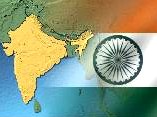


All You Need to
Know About INDIA
Government
Politics
Administrative divisions
Geography
Economy
Demographics
Culture
Last updated on
Sunday, October 29, 2006 19:28
- Mac. Dream. MX
The empire built by the Maurya dynasty under Emperor Ashoka the Great united most of modern Southern Asia except the Dravidian kingdoms in the south and laid the first foundation of a united subcontinental territory. From 180 BCE, a series of invasions from Central Asia into the north-western Indian Subcontinent followed, including the Indo-Greeks, Indo-Scythians, Indo-Parthians and the Kushans. From the third century CE, the Gupta dynasty oversaw the period referred to as ancient India's "Golden Age." While the north had larger, fewer kingdoms, in the south there were several dynasties such as the Chalukyas, Rashtrakutas, Hoysalas, Cheras, Cholas, Pallavas and Pandyas in different times and regions. The political influence of these mighty southern kingdoms, though felt to a lesser extent by north India, extended into Southeast Asia and Sri Lanka and deeply influenced their culture. The southern kingdoms remained relatively more stable and carried out maritime trade in spices and precious gems with the Arabia, China and Europe from ancient times. Science, engineering, art, literature, mathematics, astronomy, religion and philosophy flourished under the patronage of these kings.

The Sanchi stupa in Sanchi, Madhya Pradesh built by emperor Ashoka in the 3rd century BC
Following the invasions from Central Asia, between the tenth to the twelfth centuries, much of north India came under the rule of the Delhi Sultanate, and later the Mughal dynasty, who gradually expanded their reign through most of the Indian subcontinent. Nevertheless, several indigenous kingdoms flourished,in the west and the south, such as the Maratha Empire and Vijayanagara Empire. From the sixteenth century onwards, several European countries, including Portugal, Netherlands, France and the United Kingdom, started arriving as traders, and attempted to establish colonies in the subcontinent, taking advantage of the fractious nature of relations between thousands of kingdoms. At the Battle of Plassey in 1757, the British East India Company defeated the Mughals and was given Bengal. Overtaxation by the British resulted in the Famine of 1770. In 1857,a nationwide insurrection of rebelling military units and kingdoms, known as the Rebellion of 1857 broke out. This shook the British East India Company, however, the lack of an organized leadership weakened the rebellion, and inspired the British to take more power. The British again started the process of uniting the territories and even appointed symbolic Governors-General, who, in reality, were subject to the capriciousness of the Indian kings and nobles. Over the next few decades, many Indian kings and nobles cleverly used those symbolic British Governor-Generals for a western-style industrial development of their respective myriad territories. A western-style bureaucracy was raised with trained Indian people. It was during this time that the railways, telegraph and posts, military camps (cantonments) western-style educational institutes, and other industries were established. By this time the British realized that all these territories could be directly brought under the direct control of their empire. However, both the World Wars weakened Britain. The Indian freedom movement reached a cresendo between the wars when a unified territory allowed intensfication of the movement, culminating into the forging of a large powerful democratic nation. Some historians also point out that during the last decades of 19th century, the numerous Indian nobles allowed the rapid development and industrialisation initiated by the British colonial authorities, perhaps expecting an absorption of the people or eventual expulsion of the authority from the country.

Mahatma Gandhi (right) with India's first Prime Minister,
Jawaharlal Nehru
By the early twentieth century, a nationwide movement for social reforms, expulsion of non-natives, and full native governance was launched by the Indian National Congress, and various revolutionary groups. The movement was largely led by Mahatma Gandhi, with Maulana Azad, Gopal Krishna Gokhale, Lala Lajpat Rai, Bal Gangadhar Tilak, Sardar Vallabhbhai Patel, Jawaharlal Nehru, Bipin Chandra Pal and Subhash Chandra Bose playing important roles. Millions protested in various mass campaigns of civil disobedience where a very prominent philosophy was of ahimsa or non-violence. There were also armed revolts throughout this period where numerous Indians like the Chaphekar brothers, Bhagat Singh, Udham Singh, Sukhdev, Rajguru and an army of Indian soldiers under Netaji Subhash Chandra Bose used revolutionary or military means. Finally, after the Quit India movement during WWII and a number of mutinies in the armed forces after the war, the British colonial authority ended with the emergence of India as a modern democratic nation-state on 15 August 1947. This period also sowed the seeds of another nation - Pakistan, and after a blood-stained partition, the Muslim majority regions were carved out to form Pakistan. Three years later, on 26 January 1950, India ratified a new Constitution, and became a republic. Modern India thus emerged as a amalgamation of western democracy while preserving its ancient heritage laid in its first foundation in 321 BCE during Emperor Ashoka the Great's Mauryan Empire.
Since it became a democratic nation-state, India has seen sectarian violence and insurgencies in various parts of the country, but has maintained its unity and democracy. It has unresolved territorial disputes with China, which escalated into the brief Sino-Indian War in 1962; and with Pakistan, which resulted in wars in 1947, 1965, 1971 and in 1999 war in Kargil. India is a founding member of the Non-Aligned Movement and the United Nations (at the time as part of British India). In 1974, India conducted an underground nuclear test. This was followed by five more tests in 1998. Significant economic reforms beginning in 1991 have transformed India into one of the fastest-growing economies in the world.
Terms
of Service, Privacy
Policy, Contacts and Credits
© 2006 thanneer91. All rights reserved
Page tested with Internet Explorer and Mozilla Firefox
Best viewed at a resolution of 600 X 800
Any unauthourized duplication of this site is strictly prohibited and liable
to prosecution
Timeline of Indian History ~~ Military History of India ~~ Indian Independance Movement